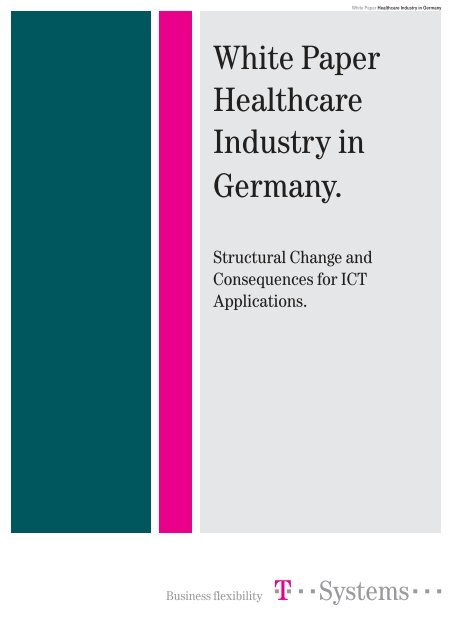White Paper Healthcare Industry in Germany.
White Paper Healthcare Industry in Germany.
White Paper Healthcare Industry in Germany.
Create successful ePaper yourself
Turn your PDF publications into a flip-book with our unique Google optimized e-Paper software.
<strong>White</strong> <strong>Paper</strong> <strong>Healthcare</strong> <strong>Industry</strong> <strong>in</strong> <strong>Germany</strong><strong>White</strong> <strong>Paper</strong><strong>Healthcare</strong><strong>Industry</strong> <strong>in</strong><strong>Germany</strong>.Structural Change andConsequences for ICTApplications.
1.1.3. Development of the <strong>Healthcare</strong> <strong>Industry</strong>.The healthcare system is primarily f<strong>in</strong>anced through <strong>in</strong>surance contributions, which are ma<strong>in</strong>ly collected from employeesand employers on a match<strong>in</strong>g basis. Just under 90% of the population is <strong>in</strong>sured <strong>in</strong> the statutory health <strong>in</strong>surance system.The contributions are geared to the respective <strong>in</strong>come level of the <strong>in</strong>sured person, whereby family members areco-<strong>in</strong>sured free-of-charge under certa<strong>in</strong> circumstances. Entitlement to benefits is <strong>in</strong>dependent of the amount of thecontributions paid, but is limited to services that are absolutely necessary. After <strong>in</strong>surance contributions, shared costsand patient surcharges make up a grow<strong>in</strong>g proportion of the f<strong>in</strong>anc<strong>in</strong>g of the healthcare system. In a few fields, subsidiesor cost-shar<strong>in</strong>g programs are funded by the state or non-profit organizations.The market for the aforementioned <strong>in</strong>dividual healthcare services (fitness, wellness, etc.) is a largely private one.The German healthcare system is subject to the <strong>in</strong>fluence a demographic change, the effects of which will become<strong>in</strong>creas<strong>in</strong>gly noticeable between now and 2015. Ow<strong>in</strong>g to what has been a cont<strong>in</strong>uously low birth rate for many years,the total population of <strong>Germany</strong> is decl<strong>in</strong><strong>in</strong>g. In parallel with this, the age structure is chang<strong>in</strong>g: longer and longer lifeexpectancy has <strong>in</strong>creased the number of older people, which contrasts with a decl<strong>in</strong><strong>in</strong>g number of children and adolescents.As older people file more claims for healthcare services than younger people do on average, the need forhealthcare services will rise rapidly <strong>in</strong> the next ten years.Figure 2: Population pyramids 2001 and 2050Source: Federal Statistical Office <strong>Germany</strong>5
1.2. Objectives of the <strong>Healthcare</strong> System.The healthcare system pursues five ma<strong>in</strong> objectives – the first three relate to healthcare services <strong>in</strong> general and to theirmedical quality, while the rema<strong>in</strong><strong>in</strong>g ones relate to their costs and to the satisfaction of the participants <strong>in</strong> the healthcaresystem:1. Each citizen must be guaranteed access to the healthcare services.2. Moreover, the quality of the healthcare services must be ensured.3. The services that are available must be effective. That means that the healthcare services received mustresult <strong>in</strong> successful treatment with<strong>in</strong> a reasonable period of time.4. Further, the healthcare services must be adm<strong>in</strong>istered <strong>in</strong> an economic fashion, i.e., when two identicalhealthcare services are available, the less expensive must be used.5. F<strong>in</strong>ally, the achievement of the aforementioned objectives should ensure the satisfaction of both the patientand the personnel work<strong>in</strong>g <strong>in</strong> the healthcare system.6
Figure 4: Contractual relationships vs. <strong>in</strong>formation flowSource: Competence Center <strong>Healthcare</strong>: T-Com 03/2004Statutory regulations that prohibit the establishment of branch pharmacies, for example, or stipulate the bus<strong>in</strong>essprocesses of doctors <strong>in</strong> private practice, have been an obstacle to network<strong>in</strong>g the service providers together with<strong>in</strong> thehealthcare system. This has led to a lower degree of ICT utilization <strong>in</strong> the healthcare sector as compared to other<strong>in</strong>dustries. The result<strong>in</strong>g need to make up for lost time, however, is becom<strong>in</strong>g <strong>in</strong>creas<strong>in</strong>gly apparent to the service providers.For this reason, statutory liberalization can be expected to br<strong>in</strong>g about rapid development of the ICT market <strong>in</strong> thehealthcare <strong>in</strong>dustry <strong>in</strong> the com<strong>in</strong>g years.8
3. Future Trends.3.1. General Trends.Despite the limited f<strong>in</strong>ancial resources of the public health <strong>in</strong>surance funds, the patients’ need for healthcare servicesis grow<strong>in</strong>g, <strong>in</strong> no small part due to an <strong>in</strong>creas<strong>in</strong>gly developed health consciousness among the German people. Forthis reason, more and more patients are will<strong>in</strong>g to <strong>in</strong>vest <strong>in</strong> the ma<strong>in</strong>tenance of their own health, even on a privatebasis.On the other side, the service providers and health <strong>in</strong>surance funds are fac<strong>in</strong>g an cost explosion: hospital costs, forexample, have risen nearly ten-fold over the past 30 years. Generally speak<strong>in</strong>g, it is clear that the entire healthcaresystem has to work and organize itself under extremely high cost pressure.The days of the hospital as sole service provider susta<strong>in</strong>ed by public fund<strong>in</strong>g are essentially over: the trend is clearlymov<strong>in</strong>g toward hospital groups, even hospital cha<strong>in</strong>s, which are run by private operators. This means these <strong>in</strong>stitutionsshould now be viewed as bona fide bus<strong>in</strong>esses whose need for ICT solutions and consult<strong>in</strong>g is just as high <strong>in</strong> proportionateterms as that of a company <strong>in</strong> the manufactur<strong>in</strong>g or service sector.As the goal of cost-effectiveness may only be achieved while ma<strong>in</strong>ta<strong>in</strong><strong>in</strong>g the quality of services, cost sav<strong>in</strong>gs cannotbe carried out on the treatment itself. Instead, the greatest cost-sav<strong>in</strong>gs potential and the highest <strong>in</strong>creases <strong>in</strong> efficiencyare to be found <strong>in</strong> the adm<strong>in</strong>istrative area. An improvement <strong>in</strong> the flow of <strong>in</strong>formation between the actors <strong>in</strong> thehealthcare system can simplify the adm<strong>in</strong>istration of patient data, provide for faster and more efficient account<strong>in</strong>gmethods, and prevent expensive duplicate treatments and wrong referrals. The key to this lies <strong>in</strong> the relevant ICTsolutions, which, hav<strong>in</strong>g already established themselves <strong>in</strong> other <strong>in</strong>dustries, have seen only isolated utilization <strong>in</strong> thehealthcare system so far.The adm<strong>in</strong>istrative cost pressure is not only evident <strong>in</strong> hospitals. Rather it is the decisive factor beh<strong>in</strong>d the trend towardthe pool<strong>in</strong>g of doctors’ practices <strong>in</strong>to group practices or even <strong>in</strong>to health cl<strong>in</strong>ics. Just like the recently legalized formationof pharmacy branches, this pool<strong>in</strong>g of resources creates a high demand for ICT.9
3.2. ICT Trends.In contrast with many other <strong>in</strong>dustries – and despite cost pressure – the healthcare system barely suffers from ICTbudget cuts. While decl<strong>in</strong><strong>in</strong>g expenditures are likely <strong>in</strong> some <strong>in</strong>dustries, ICT <strong>in</strong>vestments are expected to <strong>in</strong>crease <strong>in</strong>the healthcare system. IDC predicts that the healthcare system will cont<strong>in</strong>ue to have the highest annual growth rates ofany <strong>in</strong>dustry <strong>in</strong> the future as well. Similarly, PAC expects average growth rates of about 9% <strong>in</strong> the healthcare sectorthrough 2008.Figure 5: Success criteria for the utilization of eHealth applicationsSource: Wegweiser GmbH – eHealth StudyThis is a higher rate of growth than <strong>in</strong> every other public sector. Moreover, it is f<strong>in</strong>ancially supported through <strong>in</strong>vestments<strong>in</strong> the healthcare IT market by Western European governments. Accord<strong>in</strong>g to Gartner, the volume of this market isexpected to grow from €22.06 billion to €25.16 billion by 2008.Figure 6: Hospitals and health <strong>in</strong>surance funds: the significance of eHealthSource: Wegweiser GmbH – eHealth Study10
3.2.1. Health CardThe electronic health card conta<strong>in</strong>s a chip that <strong>in</strong>itially stores the <strong>in</strong>surance status, the authorization to be treated <strong>in</strong>European countries outside of <strong>Germany</strong>, and the electronic prescription. The latter function is designed to replace the700 million paper prescriptions that the doctors issue every year. The ePrescription works <strong>in</strong> the follow<strong>in</strong>g way:At the doctor’s officeThe doctor generates a prescription on the computer as before. He signs it with his digital signature, which is generatedus<strong>in</strong>g of his medical professional ID. The ePrescription is stored either directly on the card or on a server via a securenetwork connection.Figure 7: Health CardIn the pharmacyThe <strong>in</strong>sured person presents his health card to the pharmacist, who then calls up the prescription. Once the <strong>in</strong>suredperson has received the medication, the prescription is deleted. The electronic prescription will <strong>in</strong>itially be restricted toprescription drugs.Accord<strong>in</strong>g to M<strong>in</strong>ister of Health Ulla Schmidt, the ePrescription system can save 300 million euros per year becausethe paper document has to be re-scanned <strong>in</strong> pharmacies and data centers for account<strong>in</strong>g purposes. The electronicprescription elim<strong>in</strong>ates this breach <strong>in</strong> the electronic transmission cha<strong>in</strong>, thereby mak<strong>in</strong>g adm<strong>in</strong>istration more efficient.In addition, the patients are given the option to set up an emergency data set on their card. This allows them to storedata relative to blood type, allergies and heart conditions, for example. In this way, doctors receive treatment-relevant<strong>in</strong>formation about the patient rapidly <strong>in</strong> the event of an emergency. Storage of these emergency data sets is voluntary,however.Further functions are to be added to the card <strong>in</strong> successive iterations: <strong>in</strong> a few years, doctors will be able to use theirPC to call up the <strong>in</strong>sured person’s digitalized X-ray images, blood analyses and doctors’ letters from the card. Thiswill elim<strong>in</strong>ate costly duplicate exam<strong>in</strong>ations.11
3.2.2. Network<strong>in</strong>g of the ParticipantsFigure 8: Key to the data pool – the electronic health cardSource: www.ehealth.de/gesundheitskarte/x13.htmThe electronic network<strong>in</strong>g of the service providers as well as the pay<strong>in</strong>g authorities is currently proceed<strong>in</strong>g apace with<strong>in</strong>the framework of a series of comprehensive ICT projects. The goal of this network<strong>in</strong>g is to accelerate and improve the<strong>in</strong>formation flow relative to disease pictures, treatment documentation, prescriptions, referrals and diagnoses, but alsorelative to account<strong>in</strong>g and personal data as well. The <strong>in</strong>tegration of patient <strong>in</strong>formation beyond the separate systemsrequires the use of a large number of networks, content management systems and databases. Ow<strong>in</strong>g to the productivityand mobility <strong>in</strong>crease it affords, wireless LAN is an <strong>in</strong>terest<strong>in</strong>g topic for the healthcare sector. Mobile solutions <strong>in</strong> hospitals,for example, contribute to improved workflow.Figure 9: Workflow <strong>in</strong> the hospital with the electronic patient recordSource: M<strong>in</strong>istry of Health – the electronic patient card and its benefits12
3.2.3. DRGsDiagnosis Related Groups (DRGs) represent the prerequisite for a service-oriented hospital reimbursement system. ADRG (e.g., appendectomy) represents a pay<strong>in</strong>g authority to which the patient will be charged as a flat fee. The flat rateis based on the average treatment cost for the given treatment case. In contrast with conventional <strong>in</strong>voic<strong>in</strong>g accord<strong>in</strong>gto the length of the hospital stay, the use of DRGs results <strong>in</strong> significant cost reductions due to shortened hospitalstays. The use of DRGs requires a high performance IT system, which means an <strong>in</strong>creased IT <strong>in</strong>vestment volume fora hospital.Figure 10: DRGsSource: SAP: Implement<strong>in</strong>g DRGs successfully3.2.4. IT Outsourc<strong>in</strong>g/BPOMany medical <strong>in</strong>stitutions start by outsourc<strong>in</strong>g their IT <strong>in</strong>frastructure or even complete bus<strong>in</strong>ess processes such asthe account<strong>in</strong>g department. Above all, hospitals are <strong>in</strong>volved <strong>in</strong> this trend. In addition, topics like ERP and StorageSolutions play a major role, just as they do <strong>in</strong> private <strong>in</strong>dustry.Figure 11: Reasons for IT outsourc<strong>in</strong>gSource: The 2001 Outsourc<strong>in</strong>g World Summit3.2.5. Security and Data ProtectionOw<strong>in</strong>g to the sensitivity of the patient data, the topics of security and data protection are especially important <strong>in</strong>this <strong>in</strong>dustry. This is also borne out by current market estimates, accord<strong>in</strong>g to which <strong>in</strong>vestments <strong>in</strong> security products<strong>in</strong> the healthcare <strong>in</strong>dustry are ris<strong>in</strong>g by 17% per year. The largest market segment here is that of anti-virus solutionsand firewalls. The VPN topic is also becom<strong>in</strong>g <strong>in</strong>creas<strong>in</strong>g important, as reflected by annual growth rates of about 27%.13
4. Conclusion.Generally speak<strong>in</strong>g, it is clear that demographic factors alone are enough to ensure strong growth <strong>in</strong> the healthcare<strong>in</strong>dustry. Further, patients <strong>in</strong> an <strong>in</strong>creas<strong>in</strong>gly bus<strong>in</strong>ess-oriented healthcare system will be seen as more than merepatients, but rather as customers to whom services are be<strong>in</strong>g sold. The grow<strong>in</strong>g number of older people, i.e., potentialpatients, <strong>in</strong>creases the number of potential customers, and therefore the size of the market. It is therefore universallyaccepted that demographics are a major market driver of the healthcare <strong>in</strong>dustry.Section 2 expla<strong>in</strong>ed that the healthcare <strong>in</strong>dustry will experience more growth that any other public sector <strong>in</strong>dustry <strong>in</strong>the com<strong>in</strong>g years, and that it lags far beh<strong>in</strong>d other <strong>in</strong>dustries <strong>in</strong> terms of ICT <strong>in</strong>vestment. This by itself already serves to<strong>in</strong>dicate that the ICT providers’ medium-term resource allocation should assign a key role to the healthcare area. Thetrends discussed <strong>in</strong> Section 3 imply a high <strong>in</strong>vestment volume <strong>in</strong> hardware and software as well as services. If an ICTprovider reacts quickly now by develop<strong>in</strong>g and deliver<strong>in</strong>g <strong>in</strong>dustry-specific solutions, competitive advantages can beconsolidated <strong>in</strong> the future. The key, however, lies <strong>in</strong> the fast reaction of the provider. By 2010, the major portion of thepotentials described here will already become fact. Deutsche Telekom is positioned <strong>in</strong> the healthcare system withBasis TC Services and <strong>in</strong> selected customer segments (e.g., <strong>in</strong> hospitals) with IT services.At the present time, Deutsche Telekom AG supports 184,000 customers <strong>in</strong> the healthcare system.T-Systems will pursue three strategic thrusts designed to cover the entire eHealth market:1. As system supplier2. As application service provider3. As enabler of telematic servicesT-Systems thereby aims to secure the bus<strong>in</strong>ess with <strong>in</strong>frastructure services while rais<strong>in</strong>g newly emerg<strong>in</strong>g ICT potentials<strong>in</strong> parallel. This occurs above all through the targeted staff<strong>in</strong>g of <strong>in</strong>dustry-specific solutions – especially <strong>in</strong> the “eHealthProcesses” area. The long-term strategic objective of T-Systems is to position itself as lead<strong>in</strong>g ICT provider <strong>in</strong> the healthcaresystem.14
List of Figures.Figure 1: Participants <strong>in</strong> the German healthcare systemFigure 2: Population pyramids 2001 and 2050Figure 3: Information flow <strong>in</strong> the German healthcare systemFigure 4: Contractual relationships vs. <strong>in</strong>formation flowFigure 5: Success criteria for the utilization of eHealth applicationsFigure 6: Hospitals and health <strong>in</strong>surance funds: the significance of eHealthFigure 7: Health CardFigure 8: Key to the data pool – the electronic health cardFigure 9: Workflow <strong>in</strong> the hospital with the electronic patient recordFigure 10: DRGsFigure 11: Reasons for IT outsourc<strong>in</strong>gFigure 12: Data security15
Published by:T-Systems Enterprise Services GmbHCorporate Market<strong>in</strong>g & CommunicationsMa<strong>in</strong>zer Landstr. 5060325 Frankfurt, <strong>Germany</strong>Content responsibility:Corporate Market<strong>in</strong>g & Communications, Market IntelligenceContact:T-Systems Enterprise Services GmbHCorporate Market<strong>in</strong>g & Communications, Market IntelligenceUli KuneschFasanenweg 570771 Le<strong>in</strong>felden-Echterd<strong>in</strong>gen, <strong>Germany</strong>E-mail: Uli.Kunesch@t-systems.com




